When Bob Dylan didn’t come to Pacific University, a professor went to him
In the 1960s I was a professor at Pacific University, and along with millions, perhaps tens of millions, I was a dedicated disciple of the great Bob Dylan.
At this moment in time, he was a heroic mixture of musician, minstrel, poet, and prophet. At political events, he stood alongside Martin Luther King and Robert Kennedy. He was the most profound, and the most influential musical artist of his era. At age 25 he was known as the “voice of his generation.” His precocious profundity had never seen its equal - and has not since.
In 1966, when I learned that Dylan was scheduled to perform in Portland I immediately wrote a letter (no email, no texting, no cell phones in the 60s) to his manager asking him to persuade Dylan to come to Pacific University to speak to my Psychology class. Why not, I figured!
I received no reply.
Months later, after the Portland concert I lingered near the stage with hopes he might come out to chat, or whatever. After a few minutes, a security officer bellowed: “Is John Mitchell here?” I stepped forward and was briskly ushered to Dylan’s remarkably tiny backstage dressing room in the then-glamorous Paramount Theatre.
The security guy announced me by name and waved me into a room no bigger than a large walk-in closet with Dylan himself seated alone at its center. So, there we were the two of us.
The first minutes did not go so well. Dylan was of a sour disposition because earlier in the day he bought a leather jacket, which during the concert was stolen. This aggravated him immensely, yet despite his crankiness and tiredness, we chatted pretty much without interruption for 45 minutes. (It was years later that I realized how few people anywhere, ever, get one-on-one time with Dylan. I wish I had used those moments more wisely!)
When I entered his dressing room he says: “I hear you’re a professor.” I nodded. “So, what do you profess?” he says abruptly – and from that instant, he was pretty much in control.
I was struck by how physically small he was. He looked frail, his teeth were grey and stained. His hair spiked upward in vertical sprouts exposing scattered bald spots - weird even for the 60s - a decade of weird everything.
Hesitantly, but earnestly, I asked him about his hair. He replied, loosely translated: “Hair grows in two directions – outside your head or inside your head. Mine grows on the outside - on the inside, it strangles your brain.”
I asked him if his poetry was influenced by the famous French writers Jean-Paul Sartre and Albert Camus. I asked partly because I wrote my Master’s Thesis on Existentialism and therefore, I thought I was very smart on this topic. He answered quickly: “No, I’ve never read any of those writers. But, I know what they’re saying. I know what they’re getting at.”
This startled me, and it took me a decade to grasp that he meant exactly what he said.
At age 24 I was bright and well-read, and I had already served as a university professor for two full years, nevertheless, I did not add much intelligence to the small dressing room on this evening.
I asked Dylan how he outlined and organized his songs and he, agitatedly, said “It doesn’t work that way.” Then told me why.
I asked why he went “electric,” an unpardonable sin to his disciples. He found the question unworthy. So, on that, I learned nothing.
Remarkably, we talked back and forth freely. He told me a few things about the meaning of “Mr. Tambourine Man” but exactly what is not retained in my jingle-jangle mind.
There were no empty pauses. No blank moments. He asked me if university kids were hard to teach nowadays. I said no, they love learning. He nodded and half-grinned, but his eyes were unbelieving.
After 30 minutes of chatting, Joan Baez entered the room. She politely asked if I liked the concert, and, in the same breath, proclaimed Dylan a poetic genius, to which he showed no response. He lit another cigarette.
Shortly thereafter, quicker than at once, a big bruiser opened the door and says “Ready” – and within seconds, after hurried handshakes, they were whisked out the door, ushered into their limo, and disappeared into the night.
I was left standing alone in an empty room.
And let me tell you this: when Bob Dylan leaves a room it immediately becomes very empty.
But I was not empty! I had just exchanged thoughts, in the privacy of a small dressing room, with one of the cultural icons of the 20th century.
What a night.
Dr. John J. Mitchell was an assistant professor at Pacific University and then University of Oregon in the 1960s. Later he moved to Canada where from 1969 to 1998 he served as Professor of Child and Adolescent Psychology at the University of Alberta in Edmonton. He served as a Professor in the Faculty of Education at the University of British Columbia, Okanagan until 2012.




